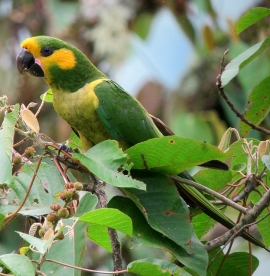Yellow-eared Parrot |
|
|
Also known as: Yellow-eared Conure or Parakeet
Photos
View in GalleryDid You Know?
The traditional roost site for Yellow-eared Conures in Ecuador has been purchased and is being re-forested, so that this bird may return to this area.Programs & Projects
WPT has worked with numerous partners to help save this species. Learn moreAcademic Research
Related publications: Ognorhynchus icterotisSpecies Profile
Genus: Ognorhynchus | Species: icterotis
Size:
42cm (16.4 in)
Weight:
285g (10 oz)
Subspecies including nominate:
one
Colour Adult:
Both adults large green parrots with long tail and heavy, grey/black bill; dark green upperparts; underparts pale green/yellow; yellow forehead, lores, upper cheeks and ear coverts; ear coverts elongated into plumes; pink/white bare skin at base of lower mandible. Eye ring bare and grey, eye orange.
Colour Juvenile:
As in adults but tail shorter and eye brown.
Call:
Unusual calls, nasal or goose-like notes given by members of group to produce far-carrying, conversational sounds.
Listen NowVideo Links:
Video 1 | Video 2More Information:
Avibase
Yellow-eared Parrot Bird Reserve
Content Sources:
CITES
BirdLife International
Cornell Lab of Ornithology/Birds of the World
A Guide to Parrots of the World, Juniper and Parr, 1998
ML Media Collection Catalogue 165268, Yellow-eared Parrot Ognorhynchus icterotis, Sarver, Matthew, Antioquia, Colombia, Dec. 12 2009, Cornell Lab of Ornithology. Site
Parrots: Status Survey and Conservation Plan 2000-2004, Snyder, McGowan, Gilardi and Grajal, 2000.
Parrots of the World, Forshaw, 2006. 2010 edition
Vanished and Vanishing Parrots, Forshaw, 2017.
Parrots in Aviculture, Low, 1992.
Photos
View in GalleryDid You Know?
The traditional roost site for Yellow-eared Conures in Ecuador has been purchased and is being re-forested, so that this bird may return to this area.Programs & Projects
WPT has worked with numerous partners to help save this species. Learn moreAcademic Research
Related publications: Ognorhynchus icterotisSpecies Care
Captive Status:
Extremely rare
Longevity:
Not recorded.
Housing:
Not recorded.
Diet:
Not recorded.
Enrichment:
Not recorded.
Nest Box Size:
Not recorded.
Clutch Size:
4
Incubation Time:
Not recorded.
Fledging Age:
Not recorded.
Hatch Weight:
Not recorded.
Peak Weight:
Not recorded.
Weaning Weight:
Not recorded.
Photos
View in GalleryDid You Know?
The traditional roost site for Yellow-eared Conures in Ecuador has been purchased and is being re-forested, so that this bird may return to this area.Programs & Projects
WPT has worked with numerous partners to help save this species. Learn moreAcademic Research
Related publications: Ognorhynchus icterotisSpecies Wild Status
World Population:
2600
IUCN Red List Status:
Vulnerable
CITES Listing:
Appendix I
Threat Summary:
Suffered a severe population collapse due to habitat loss (in particular the wax palm tree, which it is dependent on for nesting) at 90-93% in Colombia. Its status in Ecuador is unclear but precarious; it may now be extinct there. Colonial nesting behaviour could make it vulnerable to trapping.
Range:
Found in the Andean highlands in NW Ecuador, north from Pichincha and W Cotopaxi, and W Colombia, north to Antioquia and NW Norte de Santander. Recently found only from degraded localities in Cordillera Central, Colombia, and W Cotopaxi, Ecuador.
Habitat:
Found in areas with Ceroxylon wax palm trees in upland humid mountain forest. Will tolerate partially cleared areas.
Wild Diet:
Reported to feed on Ceroxylon quindiuense and C. alpinum and possibly fruit from other species in this genus; other fruits of Sanurania and Sapium spp, and Podocarpus and Euphorbiaceae.
Ecology and Behaviour:
Generally seen in small flocks or, in the breeding season, pairs. Are highly mobile, probably in response to food availability. Active at dawn feeding, then returning to roost in mid-afternoon. Noisy and conspicuous in flight. Birds roost communally.
Clutch and Egg Size:
4 eggs
Breeding Season:
Northern Tolima: May, Huila: March, Ecuador: July-October. Nests colonially in tall wax palms.
Related Links:
Photos
View in GalleryDid You Know?
The traditional roost site for Yellow-eared Conures in Ecuador has been purchased and is being re-forested, so that this bird may return to this area.Programs & Projects
WPT has worked with numerous partners to help save this species. Learn moreAcademic Research
Related publications: Ognorhynchus icterotisMembers Only Resources
Please log-in now to find more research, resources and tools.
Not a Member?
Find more great information:
Gain exclusive access to 600+ pages of additional research, seminars and podcasts, specialists to ask your toughest questions, and dozens of other fun resources - when you become a WPT member.
Join Today >>

































